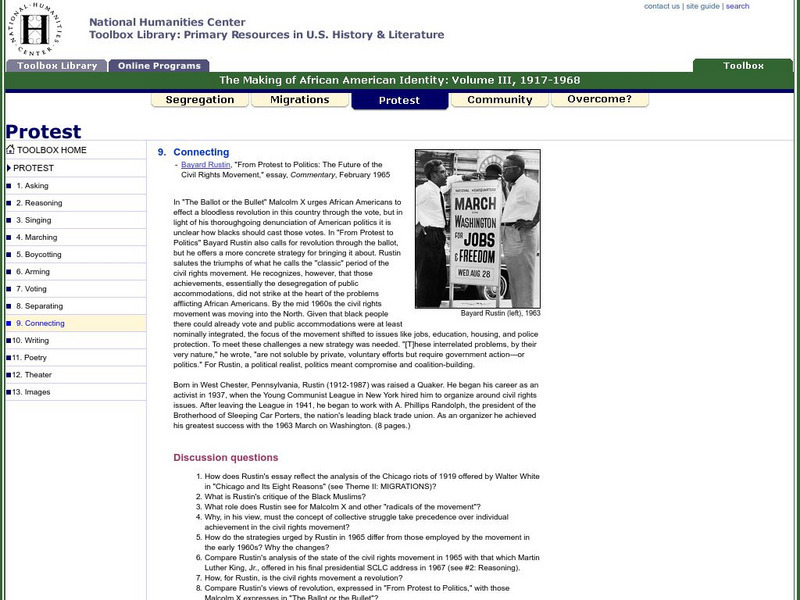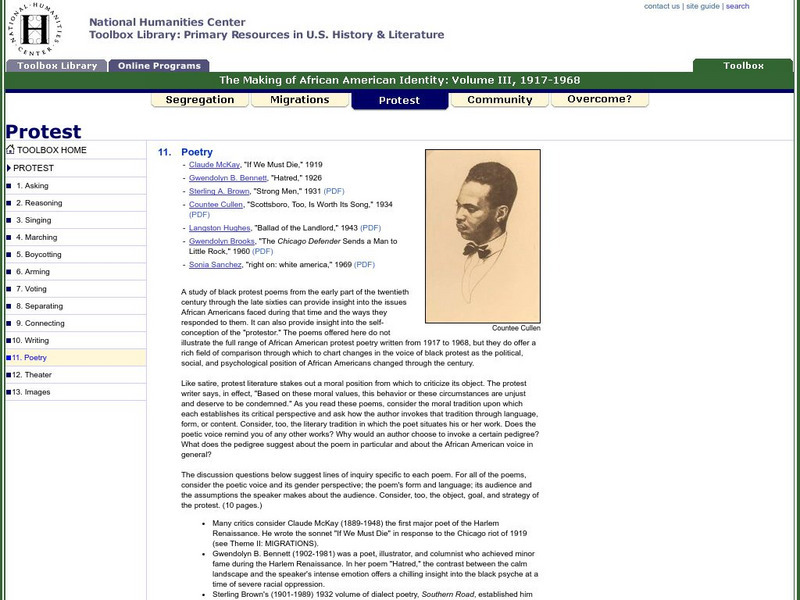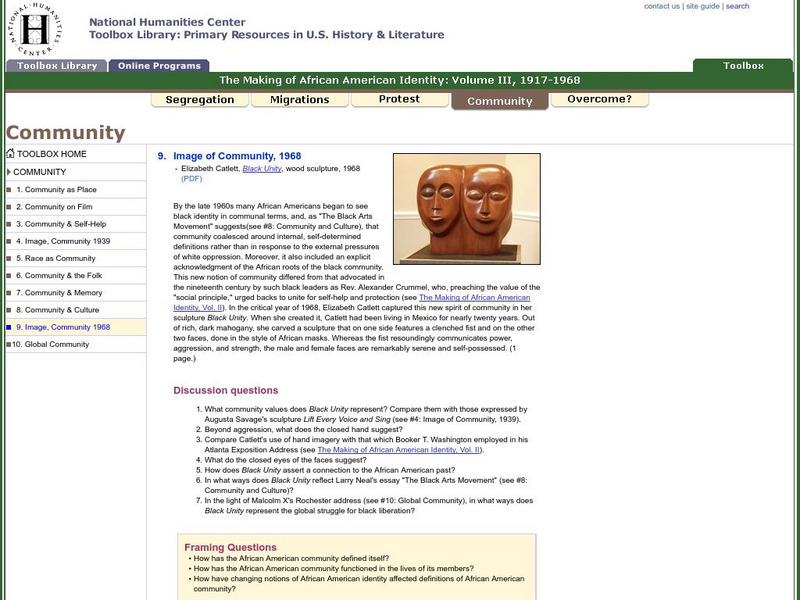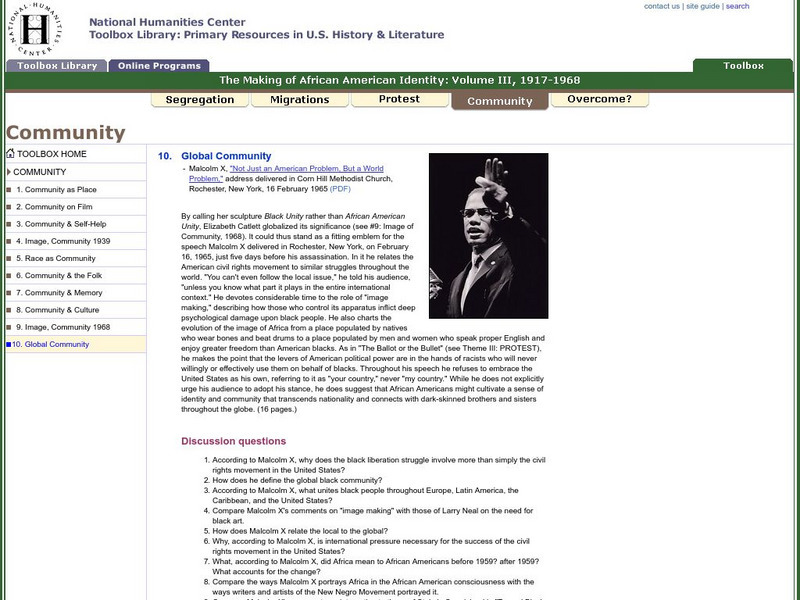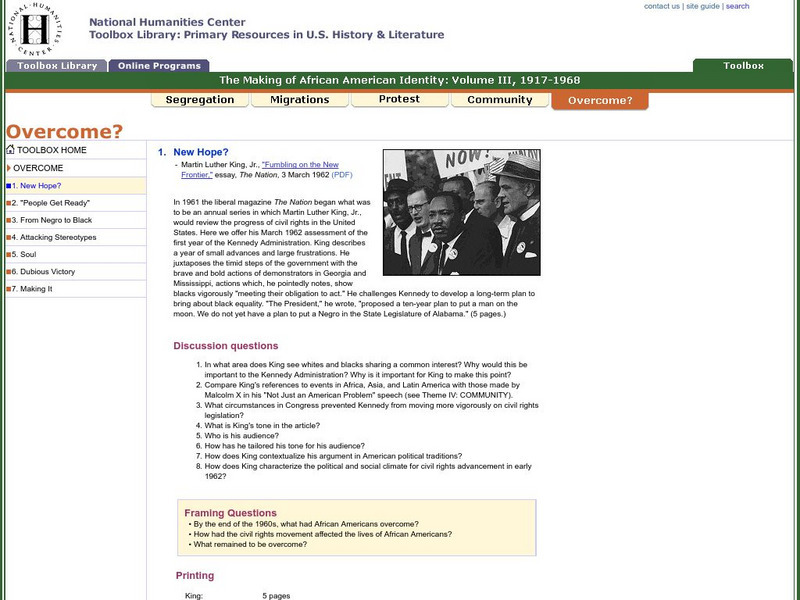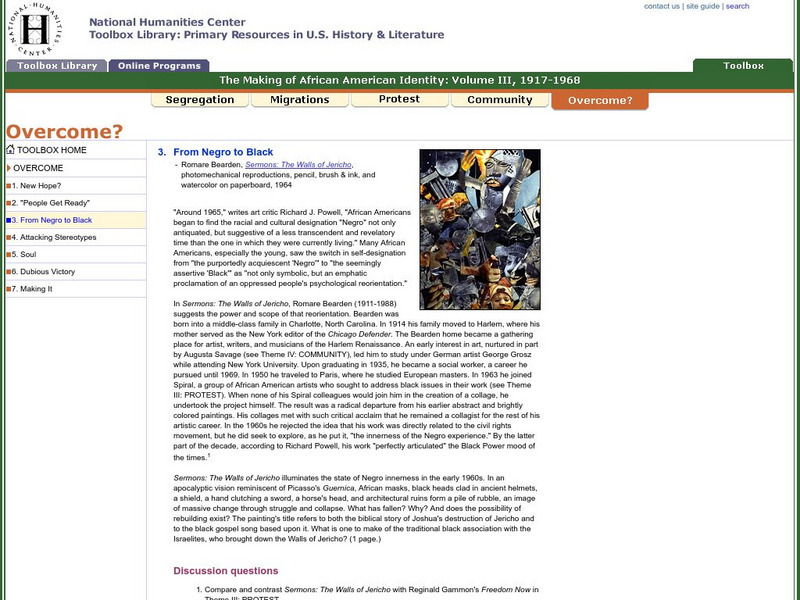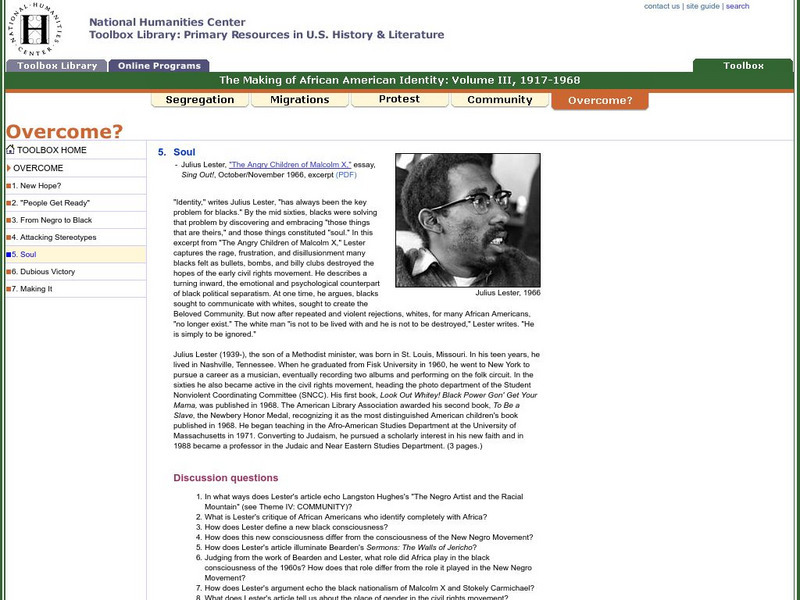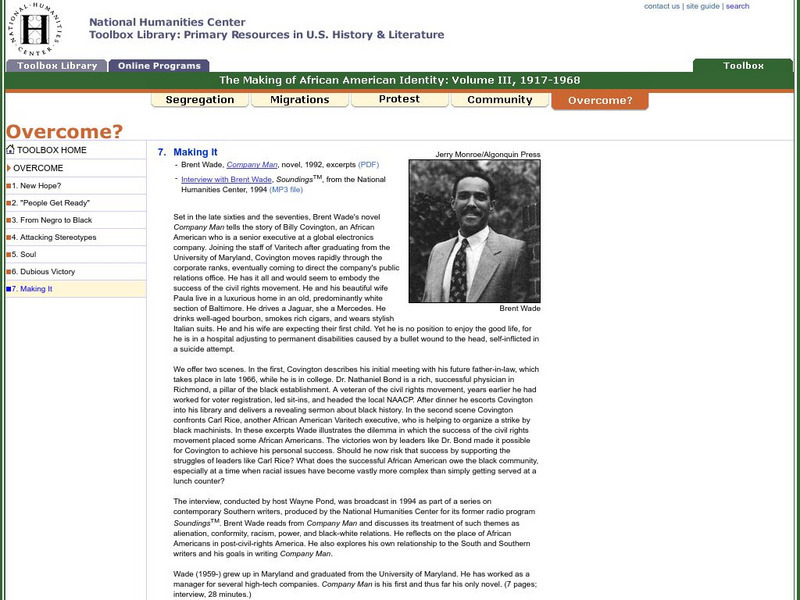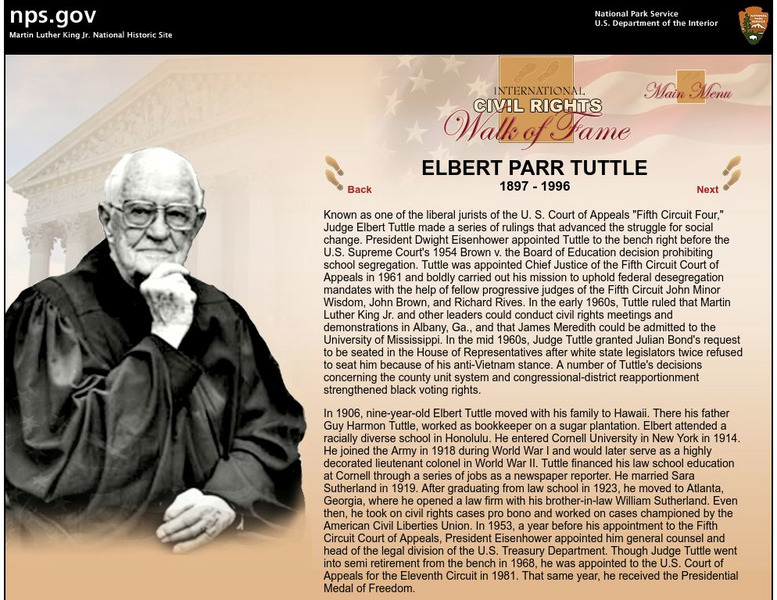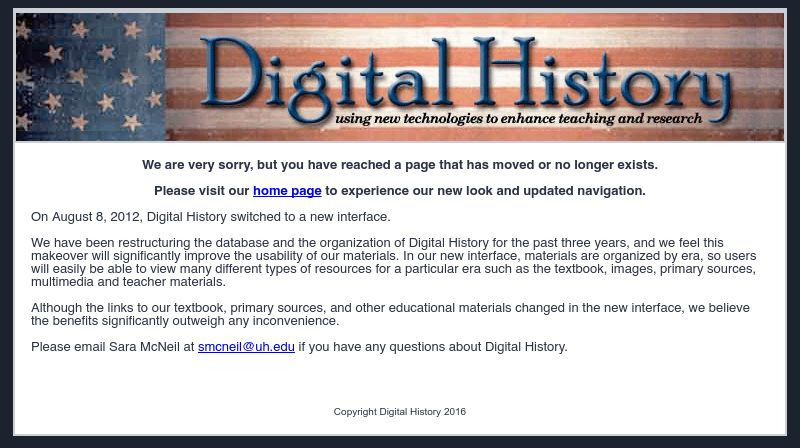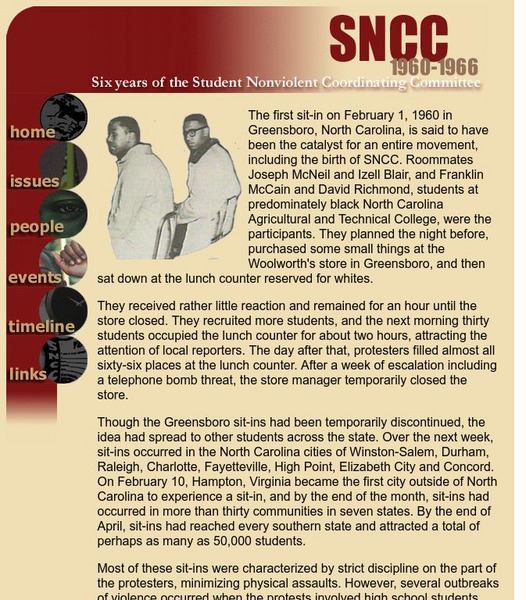National Humanities Center
National Humanities Center: Toolbox Library: Connecting: Making of African American Identity: V. 3
An article that makes a case for black engagement with the American political system. This resource provides a link to Bayard Rustin's "From Protest to Politics", where he encourages African Americans to begin a "revolution through the...
National Humanities Center
National Humanities Center: Toolbox Library: Poetry, Making of African American Identity: V. 3
This study of black protest poems from the early part of the twentieth century through the late sixties can provide insight into the issues African Americans faced during that time and the ways they responded to them. Works from seven...
National Humanities Center
National Humanities Center: Toolbox Library: Theater, Making of African American Identity: V. 3
A manifesto and scenes from a play illustrating black protest in the theater. LeRoi Jones's short manifesto, "The Revolutionary Theatre," and Douglas Turner Ward's, " Day of Absence" encapsulates the mindset of many black writers and...
National Humanities Center
National Humanities Center: Toolbox Library: Images, Making of African American Identity: V. 3
This article review examples of black protest in art by Claude Clark and Charles White. Links to images and supplemental resources are provided here as well.
National Humanities Center
National Humanities Center: Toolbox Library: Community on Film, Making of African American Identity: V. 3
Excerpts from a 1941 film that depicts black and white communities in Kannapolis, NC, by H. Lee Waters (1902-1997). This two part film characterizes the differences in economy, community, and values of two separate cultures.
National Humanities Center
National Humanities Center: Toolbox Library: Community & Self Help, Making of African American Identity:v. 3
An interview illustrating some of the ways community functioned in the lives of African Americans. It explores how external pressures of racism brought African Americans together to form fraternal organizations and entire towns.
National Humanities Center
National Humanities Center: Toolbox Library: Image of Community, 1939, Making of African American Identity
This resources illustrates how artist Augusta Savage (1892-1962) embodied the virtues of self-help, self-reliance, and close-knit cohesion of the black community in her sculpture Lift Every Voice and Sing (The Harp).
National Humanities Center
National Humanities Center: Toolbox Library: Race as Community, Making of African American Identity: V. 3
Articles illustrating how African Americans defined community according to perceptions of race. Links are provided to these works by George Schuyler, Langston Hughes, E. Franklin Frazier.
National Humanities Center
National Humanities Center: Toolbox Library: Community and the Folk, Making of African American Identity: V. 3
A story that examines African American community in a rural setting. Zora Neale Hurston's (1891-1960) brief tale "Spunk" is provided within this resources and documents the expressions of southern black "folk."
National Humanities Center
National Humanities Center: Toolbox Library: Community and Memory, Making of African American Identity: V. 3
A story that defines community as a connection between the past and the present. This resource links to Henry Dumas's short story, "Ark of Bones" and reviews its social commentary as it applies to African American community.
National Humanities Center
National Humanities Center: Toolbox Library: Community and Culture, Making of African American Identity: V. 3
An attempt to define community as a shared culture. In this article and review, critic, poet, and playwright Larry Neal (1937-1981) applies the principles of self-determination espoused by Stokely Carmichael and others to the arts and...
National Humanities Center
National Humanities Center: Toolbox Library: Image of Community, 1968, Making of African American Identity: V.
This article describes the history associated with the sculpture Black Unity, an image of African American community in 1968 by Elizabeth Catlett.
National Humanities Center
National Humanities Center: Toolbox Library: Global Community, Making of African American Identity: V. 3
On February 16, 1965, in Rochester, New York, Malcolm X delivered a speech that placed African American in a global black community. Just five days before his assassination, he relates the American civil rights movement to similar...
National Humanities Center
National Humanities Center: Toolbox Library: New Hope?, Making of African American Identity: V. 3
An article that critiques the early civil rights efforts of the Kennedy administration. It explores the obstacles the civil rights movement had to overcome and the movement's effect on the lives of African Americans.
National Humanities Center
National Humanities Center: Toolbox Library: From Negro to Black, Making of African American Identity: V. 3
A painting that expresses the darkening hopes of the civil rights movement. It explores the obstacles the civil rights movement had to overcome and the movement's effect on the lives of African Americans.
National Humanities Center
National Humanities Center: Toolbox Library: Attacking Stereotypes, Making of African American Identity: V. 3
Two images that express the growing militancy of the civil rights movement in the 1960s. This article explains how Joe Overstreet (1934-) and Betye Saar (1929-) went head to head with the formidable Aunt Jemima and with wit and irony...
National Humanities Center
National Humanities Center: Toolbox Library: Soul, Making of African American Identity: V. 3
An article that expresses the late 1960s disillusionment of the civil rights movement. It explores the obstacles the civil rights movement had to overcome and the movement's affect on the lives of African Americans.
National Humanities Center
National Humanities Center: Toolbox Library: Dubious Victory, Making of African American Identity: V. 3
An article that describes the price paid by African Americans for school desegregation. The story of six-year-old Tracy Price Thompson is described and link to her memoir is provided.
National Humanities Center
National Humanities Center: Toolbox Library: Making It, Making of African American Identity: V. 3
Excerpts from a novel and an interview that illustrate where the success of the civil rights movement left some middle class African Americans. They explore the obstacles the civil rights movement had to overcome and the movement's...
Curated OER
National Park Service: International Civil Rights Walk of Fame: Elbert Tuttle
Judge Elbert Tuttle was influential during and following the Civil Rights Movement as described in this concise biography.
Digital History
Digital History: Simple Justice
Follow the civil rights quest for integrated schools from the beginning in 1849 through the 1954 Supreme Court decision in Brown v. the Topeka Board of Education and the struggle that ensued for decades following in the most reluctant...
Curated OER
National Park Service: We Shall Overcome: Lincoln Memorial
Pictures and text recount the March on Washington and King's speech at the Lincoln Memorial at this National Park Service site.
ibiblio
Ibiblio: Greensboro Sit Ins
This site, which is provided for by Ibiblio, contains a background of the beginning and subsequent spread of the sit-ins during the 1960s.
ibiblio
Ibiblio: Student Nonviolent Coordinating Committee
This ibiblio.org site gives the six-year history of this college based group that supported the civil rights movement and tells of its nonviolent philosophy.
